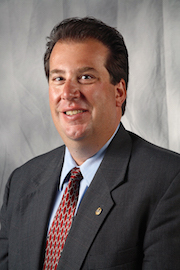Advancing engineering for a better society: Los Alamos leader named UW-Madison Grainger Institute director
“The ages of human development are based on the materials peoples of the day used: the Stone Age, the Bronze Age, the Iron Age,” says Dan Thoma, deputy division leader for the Los Alamos National Laboratory (LANL) Materials Science and Technology Division. “Technology is the driver. Materials are the enabler — so that discovery point is really what impacts society.”

Dan Thoma is the director of the Grainger institute for Engineering at the University of Wisconsin–Madison.
In June, Thoma will become the first director of the Grainger Institute for Engineering at the University of Wisconsin–Madison. Funded in 2014 with $25 million from The Grainger Foundation of Lake Forest, Illinois, the institute is an incubator for transdisciplinary research in the UW–Madison College of Engineering.
The institute’s first focus areas — advanced manufacturing and accelerated materials discovery — center around the idea that new materials benefit everyone. These intertwined areas are critical to state and national manufacturers’ economic competitiveness in a global marketplace. “A lot of advanced manufacturing now can be summarized as ‘twice as fast; twice as cheap,” says Thoma.
Thoma, who is an active leader in national and international materials societies, brings to the institute a particular passion for using scientific and engineering advances to solve challenges that affect society and human well-being. He has spent much of his professional life focused on developing teams of talented people. “In each case, I’ve been asked to build something new,” he says. “I like that challenge.”
Early in his career at LANL, he was charged with creating an alloy design and development team, then moved on to direct the laboratory’s Materials Design Institute, a collaborative research program with the University of California. In that role, his responsibilities included interacting with several universities and developing a talent pipeline for the lab. He also became an adjunct professor of materials science and chemical engineering at UC Davis, where he taught classes and supervised student research. In 2013, he took over as deputy division leader for the LANL Materials Science and Technology Division, a 220-person organization that focuses on materials processing and research.
In a way, Thoma’s career has come full circle: He is a UW–Madison alumnus who earned his Ph.D. in metallurgical engineering in 1992 under renowned materials innovator John Perepezko, a professor of materials science and engineering. “I still know a lot of the people; I still know a lot of the capabilities,” says Thoma. “But what blew me away when I’ve visited over the last decade or so is some of the new hires, the early-career faculty. There’s so much talent.”
He will tap existing and new talent — he already is involved in the hiring processes for as many as nine new faculty members, who will approach their research in the Grainger Institute in transdisciplinary teams — to tackle significant challenges that currently hinder manufacturers’ ability to integrate innovative new materials into their products.
One bottleneck that can add years to the process for translating research discoveries into commercial products is “qualification” — in other words, extensive testing to ensure new materials will perform as expected.
“Even if we can do discovery and we develop all these new tools, how do we get them to market faster? How do we really impact society?” Thoma says. “The big issue right now is how do we jump technical readiness levels? How do we take a discovery into the prototype stage, and this prototype into production? There’s this notion of a ‘valley of death’ — this gap in taking engineering research into higher readiness levels. That can only be accomplished with a multidisciplinary approach.”
Grainger Institute researchers also will work to improve methods for controlling external variables and predicting a new material’s performance as it’s scaled up from the lab — another area that can hasten manufacturers’ use of that new material. And in all of their efforts, they will work to incorporate methods that use resources in a sustainable way.
Wisconsin is the ideal place to address such issues — not only because the university already has significant research expertise, but also because manufacturing is a major industry in the state. “Everything is in place that just makes this so natural,” says Thoma. “The university has always been scientifically relevant, and relevant on a technical and engineering level. It has been a resource and a pipeline for industry, and now we can start developing these interactions and capabilities that can benefit industry.”
Thoma comes to Wisconsin with extensive industry connections throughout the United States, and he plans to establish additional partnerships with state and national manufacturers in an effort to tap their skills and to better understand and meet their needs.
Looking back on his experience as an educator, Thoma is excited at the prospect of inspiring UW–Madison engineering students and impacting their development through the institute. He says students at all levels can benefit from participating in research, learning how to translate advances to industry, and working in the institute’s multidisciplinary environment. “That’s the future of science and engineering — even coming out of funding agencies in Washington,” he says. “They’re looking for that ability to be able to communicate and work in teams — and you can’t teach that as much in classroom environments. It has to be practiced.”
That focus on bringing many diverse skills to the institute is something Thoma believes strongly in. “We stress that materials are the enabler, but how you implement them in technology requires so many skill sets,” he says. “That’s why it just can’t be done with a materials perspective. And that’s what’s going to make the Grainger Institute so different, so great — because it encompasses all these disciplines.”
The institute’s focus on transdisciplinary research also played a major role in Thoma’s decision to become its director. “It just so happens that the two subject areas are areas I’m very comfortable and familiar with, but it requires skill sets for implementation that I couldn’t do as an individual,” he says. “And this shared vision for the Grainger Institute is something that I immediately hit onto. To implement that common vision is a career goal of mine. So I think it’s going to be challenging but exciting. It’s going to be a blast.”
Subscribe to Wisconsin Ideas
Want more stories of the Wisconsin Idea in action? Sign-up for our monthly e-newsletter highlighting how Badgers are taking their education and research beyond the boundaries of the classroom to improve lives.
Tags: business, engineering, research, The Wisconsin Idea


